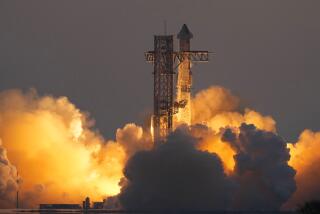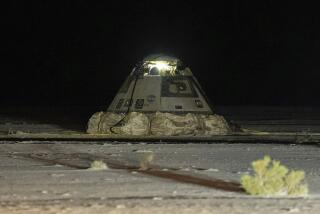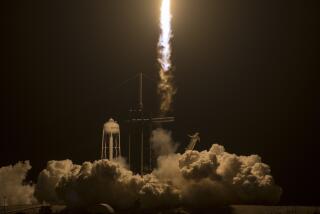Shuttle Ends Military Job Successfully : Officials Still Silent on Apparent Spy Satellite Launch
- Share via
KENNEDY SPACE CENTER, Fla. — The space shuttle Discovery glided back to Earth on Sunday after successfully firing a once-failed rocket system and, apparently, turning loose in space a supersensitive spy satellite.
The flight--the 15th by a reusable U.S. shuttle spacecraft and the third by Discovery--ended in the same shroud of mystery that enveloped its launch. The mission marked a major step in the United States’ use of the heavens for military operations.
“The crew has been welcomed home and Mission 51-C has come to a successful conclusion,” said Mission Control after the shuttle rolled to a stop.
Early Landing
The shuttle touched down at the Kennedy Space Center’s 15,000-foot landing strip at 4:23 p.m., 3 days, 1 hour and 33 minutes after it had blasted away from the launching pad last Thursday afternoon. The craft arrived one day earlier than had been expected, apparently brought home out of concern that the clear, dry, springlike weather of Sunday might give way to wind and rain--poor landing conditions--today.
However, virtually all operational details of the flight were kept secret, including its intended duration. The landing time was announced 16 hours before it occurred.
When Discovery and its five crew members returned to Earth, they completed the shortest mission of a shuttle craft since the program’s four test flights were completed and regular operations began in November, 1982.
Twin Sonic Booms
Discovery began its descent about 150 miles southwest of Australia, slicing through the upper limits of the atmosphere on a downward glide from the other side of the globe. It crossed over central Florida, signaled its’ arrival with twin sonic booms about 40,000 feet above the space center and began a long, sweeping 270-degree turn that brought it down to the runway.
The Air Force, which is paying the National Aeronautics and Space Administration $31.2 million for the approximately $125-million flight, proclaimed the operation a success but had little to say beyond that.
It would not confirm that a satellite had been carried aloft by the shuttle, let alone that it was launched from the cargo bay and had moved into position to help monitor radar, radio and other electronic transmissions from the western Soviet Union. According to a published report, such surveillance could help alert the United States to Soviet preparations for a nuclear war.
The customary post-flight news conference by space agency officials was skipped. Even details of the spacecraft’s passage over the United States were withheld, out of concern that any information could tip the Soviets to the operations of the satellite.
Aboard the shuttle were the commander, Navy Capt. Thomas K. Mattingly; the pilot, Air Force Lt. Col. Loren J. Shriver; Air Force Maj. Ellison S. Onizuka; Marine Lt. Col. James F. Buchli, and Air Force Maj. Gary E. Payton.
The crew members, in light-blue coverall flight suits, emerged from the gleaming white spaceship about 45 minutes after it landed. They walked around the ship, giving it a quick inspection and then headed off to shower and prepare for their trip home to Houston.
Operating under tight restrictions imposed by the Air Force, the space agency--in a statement issued jointly with the Air Force--said early Sunday that the booster rocket, known as an inertial upper stage, or IUS, had performed properly.
The mechanism’s function is to propel a payload weighing up to 5,000 pounds from the shuttle cargo bay.
It did that with apparent ease, encountering none of the problems that hampered the first use of the device aboard the shuttle in April, 1983. At that time, a nozzle steering mechanism overheated, leading it to send a tracking and data relay satellite tumbling uselessly into a wrong orbit that was only corrected when separate, tiny rockets were fired to nudge it back into position.
The booster rocket was crucial to the current mission and will be equally important to the next shuttle flight. On Feb. 20, NASA is scheduled to send the shuttle Challenger aloft to launch a second tracking and data relay satellite. On that mission, Sen. Jake Garn (R-Utah) is scheduled to be the first politician passenger on a shuttle flight.
William Rice, a spokesman for the Boeing Aerospace Co., which manufactures the $50-million inertial upper stage rocket, said the company had been confident that the 1983 problem had been corrected, “but with a good flight under our belt, we think we can get on with an operational IUS program.”
The mechanism lifts the cargo--in this case a satellite--out of the shuttle’s cargo storage hold, propels it away from the aircraft, and then, when it is 10 miles away, fires the first of two rocket blasts to push it into orbit.
The first firing propels the satellite toward a point 22,300 miles away from the Earth. The second firing, approximately six hours after the first, places the satellite in the proper “geosynchronous” orbit, where it travels at the same speed as the rotating planet and remains “parked” in one position above the Equator.
As for the performance of the shuttle, Dick Young, a NASA spokesman, said that no problems had been detected during the flight.
“We’ll reach the point that the people see this as proven hardware, and ask, ‘What’s the big thing?’ ” he said.
More to Read
Sign up for Essential California
The most important California stories and recommendations in your inbox every morning.
You may occasionally receive promotional content from the Los Angeles Times.










